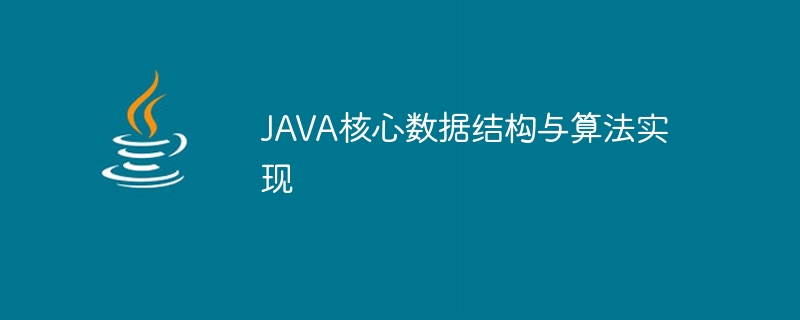Heim >Java >javaLernprogramm >JAVA-Kerndatenstruktur und Algorithmusimplementierung
JAVA-Kerndatenstruktur und Algorithmusimplementierung
- PHPzOriginal
- 2023-11-08 12:35:151261Durchsuche

Aufgrund des begrenzten Platzes des Artikels werde ich einige Implementierungsbeispiele für wichtige Datenstrukturen und Algorithmen bereitstellen. Zunächst werden mehrere Kerndatenstrukturen und Algorithmen vorgestellt und anschließend entsprechende Java-Codebeispiele gegeben.
-
Array
- Implementieren Sie ein dynamisch erweitertes Array.
- Implementieren Sie die Operationen zum Hinzufügen, Löschen, Ändern und Überprüfen des Arrays.
public class DynamicArray<T> {
private Object[] array;
private int size;
private int capacity;
public DynamicArray() {
capacity = 10;
array = new Object[capacity];
size = 0;
}
public void add(T element) {
if (size == capacity) {
capacity *= 2;
Object[] newArray = new Object[capacity];
System.arraycopy(array, 0, newArray, 0, size);
array = newArray;
}
array[size++] = element;
}
public T get(int index) {
if (index < 0 || index >= size) throw new IndexOutOfBoundsException();
return (T) array[index];
}
public void remove(int index) {
if (index < 0 || index >= size) throw new IndexOutOfBoundsException();
for (int i = index; i < size - 1; i++) {
array[i] = array[i + 1];
}
size--;
}
}-
verknüpfte Liste
implementieren Sie die Operationen der verknüpften Liste hinzufügen, löschen, ändern und überprüfen. Operationpublic class ListNode { int val; ListNode next; ListNode(int val) { this.val = val; } } public class LinkedList { private ListNode head; public void addAtHead(int val) { ListNode newHead = new ListNode(val); newHead.next = head; head = newHead; } public void addAtTail(int val) { if (head == null) { head = new ListNode(val); } else { ListNode current = head; while (current.next != null) { current = current.next; } current.next = new ListNode(val); } } public void deleteAtIndex(int index) { if (index == 0) { head = head.next; return; } int count = 0; ListNode current = head; ListNode prev = null; while (current != null && count < index) { prev = current; current = current.next; count++; } if (current != null) { prev.next = current.next; } } public ListNode get(int index) { ListNode current = head; int count = 0; while (current != null && count < index) { current = current.next; count++; } return current; } }
Stack
- Implementieren Sie einen Array-basierten Stack. Implementieren Sie Stack Push, Pop und andere Operationen
- implement Ein Array-basiertes Warteschlangenbetriebs-Warteschlangenbetrieb wie Enqueueing und Dequeing
public class ArrayStack { private int[] array; private int top; private int capacity; public ArrayStack(int capacity) { this.capacity = capacity; array = new int[capacity]; top = -1; } public void push(int value) { if (top == capacity - 1) throw new IllegalStateException("Stack is full"); array[++top] = value; } public int pop() { if (top == -1) throw new IllegalStateException("Stack is empty"); return array[top--]; } public int peek() { if (top == -1) throw new IllegalStateException("Stack is empty"); return array[top]; } public boolean isEmpty() { return top == -1; } }
-
implement Bubble-Sortierung, Insertionssorte, Auswahlsorten, Schnellsorten und andere Algorithmen
public class ArrayQueue { private int[] array; private int front; private int rear; private int capacity; public ArrayQueue(int capacity) { this.capacity = capacity; array = new int[capacity]; front = 0; rear = -1; } public void enqueue(int value) { if (rear == capacity - 1) throw new IllegalStateException("Queue is full"); array[++rear] = value; } public int dequeue() { if (isEmpty()) throw new IllegalStateException("Queue is empty"); int value = array[front]; front++; return value; } public int peek() { if (isEmpty()) throw new IllegalStateException("Queue is empty"); return array[front]; } public boolean isEmpty() { return front > rear; } } - Das Obige sind einige Kerndatenstrukturen und Java-Implementierungsbeispiele für Algorithmen. Ich hoffe, es wird Ihnen hilfreich sein.
Das obige ist der detaillierte Inhalt vonJAVA-Kerndatenstruktur und Algorithmusimplementierung. Für weitere Informationen folgen Sie bitte anderen verwandten Artikeln auf der PHP chinesischen Website!
Stellungnahme:
Der Inhalt dieses Artikels wird freiwillig von Internetnutzern beigesteuert und das Urheberrecht liegt beim ursprünglichen Autor. Diese Website übernimmt keine entsprechende rechtliche Verantwortung. Wenn Sie Inhalte finden, bei denen der Verdacht eines Plagiats oder einer Rechtsverletzung besteht, wenden Sie sich bitte an admin@php.cn

